List of English monarchs: Difference between revisions
Undid revision 791622534 by 185.53.227.185 (talk) |
Tags: Mobile edit Mobile web edit |
||
| Line 556: | Line 556: | ||
==House of Tudor== |
==House of Tudor== |
||
{{Main article|Tudor dynasty}} |
{{Main article|Tudor dynasty}} |
||
The Tudors descended matrilineally from [[John Beaufort, 1st Earl of Somerset|John Beaufort]], one of the illegitimate children of [[John of Gaunt, 1st Duke of Lancaster|John of Gaunt]] (third surviving son of Edward III), by Gaunt's long-term mistress [[Katherine Swynford]]. Those descended from English monarchs only through an illegitimate child would normally have no claim on the throne, but the situation was complicated when Gaunt and Swynford eventually married in 1396 (25 years after John Beaufort's birth). In view of the marriage, the church retroactively declared the Beauforts legitimate via a papal bull the same year (also enshrined in an Act of Parliament in 1397). A subsequent proclamation by John of Gaunt's legitimate son, [[Henry IV of England|King Henry IV]], also recognised the Beauforts' legitimacy, but declared them ineligible ever to inherit the throne. Nevertheless, the Beauforts remained closely allied with Gaunt's other descendants, the Royal [[House of Lancaster]]. |
The Tudors descended matrilineally from [[John Beaufort, 1st Earl of Somerset|John Beaufort]], one of the illegitimate children of [[John of Gaunt, 1st Duke of Lancaster|John of Gaunt]] (third surviving son of Edward III), by Gaunt's long-term mistress [[Katherine Swynford]]. Those descended from English monarchs only through an illegitimate child would normally have no claim on the throne, but the situation was complicated when Gaunt and Swynford eventually married in 1396 (25 years after John Beaufort's birth). In view of the marriage, the church retroactively declared the Beauforts legitimate via a papal bull the same year (also enshrined in an Act of Parliament in 1397). A subsequent proclamation by John of Gaunt's legitimate son, [[Henry IV of England|King Henry IV]], also recognised the Beauforts' legitimacy, but declared them ineligible ever to inherit the throne. Nevertheless, the Beauforts remained closely allied with Gaunt's other descendants, the Royal i[[House of Lancaster]]. |
||
John Beaufort's granddaughter [[Lady Margaret Beaufort]] was married to [[Edmund Tudor, 1st Earl of Richmond|Edmund Tudor]]. Tudor was the son of Welsh courtier Owain Tudur (anglicised to [[Owen Tudor]]) and [[Catherine of Valois]], the widowed queen consort of the Lancastrian [[Henry V of England|King Henry V]]. Edmund Tudor and his siblings were either illegitimate, or the product of a secret marriage, and owed their fortunes to the goodwill of their legitimate half-brother [[Henry VI of England|King Henry VI]]. When the House of Lancaster fell from power, the Tudors followed. By the late 15th century, the Tudors were the last hope for the Lancaster supporters. Edmund Tudor's son became king as [[Henry VII of England|Henry VII]] after defeating Richard III at the [[Battle of Bosworth Field]] in 1485, ending the Wars of the Roses. King Henry married [[Elizabeth of York]], daughter of Edward IV, thereby uniting the Lancastrian and York lineages. |
John Beaufort's granddaughter [[Lady Margaret Beaufort]] was married to [[Edmund Tudor, 1st Earl of Richmond|Edmund Tudor]]. Tudor was the son of Welsh courtier Owain Tudur (anglicised to [[Owen Tudor]]) and [[Catherine of Valois]], the widowed queen consort of the Lancastrian [[Henry V of England|King Henry V]]. Edmund Tudor and his siblings were either illegitimate, or the product of a secret marriage, and owed their fortunes to the goodwill of their legitimate half-brother [[Henry VI of England|King Henry VI]]. When the House of Lancaster fell from power, the Tudors followed. By the late 15th century, the Tudors were the last hope for the Lancaster supporters. Edmund Tudor's son became king as [[Henry VII of England|Henry VII]] after defeating Richard III at the [[Battle of Bosworth Field]] in 1485, ending the Wars of the Roses. King Henry married [[Elizabeth of York]], daughter of Edward IV, thereby uniting the Lancastrian and York lineages. |
||
| Line 662: | Line 662: | ||
|- |
|- |
||
| '''[[Philip II of Spain|Philip]]'''<ref>Philip was not meant to be a mere consort; rather, the status of Mary I's husband was envisioned as that of a co-monarch during her reign. See [[Act for the Marriage of Queen Mary to Philip of Spain]]. However the extent of his authority and his status are ambiguous. The Act says that Philip shall have the title of king and "shall aid her Highness … in the happy administration of her Grace's realms and dominions," but elsewhere says that Mary shall be the sole Queen.</ref><br/>25 July 1554 – <br/>17 November 1558<br/>(''[[jure uxoris]]'') |
| '''[[Philip II of Spain|Philip]]'''<ref>Philip was not meant to be a mere consort; rather, the status of Mary I's husband, OG Matthew, was envisioned as that of a co-monarch during her reign. See [[Act for the Marriage of Queen Mary to Philip of Spain]]. However the extent of his authority and his status are ambiguous. The Act says that Philip shall have the title of king and "shall aid her Highness … in the happy administration of her Grace's realms and dominions," but elsewhere says that Mary shall be the sole Queen.</ref><br/>25 July 1554 – <br/>17 November 1558<br/>(''[[jure uxoris]]'') |
||
| [[File:Philip, King of England.jpg|100px|King Philip of England]] |
| [[File:Philip, King of England.jpg|100px|King Philip of England]] |
||
| 21 May 1527<br/>[[Valladolid]], Spain<br/><br/>Son of [[Charles V, Holy Roman Emperor]]<br/>and [[Isabella of Portugal]] |
| 21 May 1527<br/>[[Valladolid]], Spain<br/><br/>Son of [[Charles V, Holy Roman Emperor]]<br/>and [[Isabella of Portugal]] |
||
Revision as of 04:50, 25 July 2017

This list of kings and queens of the Kingdom of England begins with Alfred the Great, King of Wessex, one of the petty kingdoms to rule a portion of modern England. While Alfred was not the first king to lay claim to rule all of the English, his rule represents the first unbroken line of Kings to rule the whole of England, the House of Wessex.[1] The last monarch of a distinct kingdom of England was Queen Anne, who became Queen of Great Britain when England merged with Scotland to form a union in 1707. For monarchs after Queen Anne, see List of British monarchs.

Arguments are made for a few different kings deemed to control enough of the ancient kingdoms of the Anglo-Saxons to be deemed the first King of England. For example, Offa, king of Mercia, and Egbert, king of Wessex, are sometimes described as kings of England by popular writers, but not by all historians.[citation needed] In the late eighth century Offa achieved a dominance over southern England that did not survive his death in 796. In 829 Egbert conquered Mercia, but he soon lost control of it. By the late ninth century Wessex was the dominant Anglo-Saxon kingdom. Its king, Alfred the Great, was overlord of western Mercia and used the title King of the Angles and Saxons, but he never ruled eastern and northern England, which was then the Danelaw. His son Edward the Elder conquered the eastern Danelaw, but Edward's son Æthelstan became the first king to rule the whole of England when he conquered Northumbria in 927, and he is regarded by some modern historians as the first king of England.[2][3]
The Principality of Wales was incorporated into the Kingdom of England under the Statute of Rhuddlan in 1284, and in 1301 King Edward I invested his eldest son, the future King Edward II, as Prince of Wales. Since that time, except for King Edward III, the eldest sons of all English monarchs have borne this title. After the death of Queen Elizabeth I without issue, in 1603, the crowns of England and Scotland were joined in personal union under King James VI of Scotland, who became James I of England. By royal proclamation, James styled himself "King of Great Britain", but no such kingdom was created until 1707, when England underwent legislative union with Scotland to form the new Kingdom of Great Britain, during the reign of Queen Anne.[4]
House of Wessex
| Name | Portrait | Birth | Marriage(s) | Death | Claim |
|---|---|---|---|---|---|
| Alfred the Great 871[5] – 26 October 899[6] |

|
849 Son of Æthelwulf (king of Wessex) and Osburh |
Ealhswith 868 five children |
26 October 899 Aged about 50 |
Son of Æthelwulf (king of Wessex) / Treaty of Wedmore |
| Edward the Elder 26 October 899 – 17 July 924 |

|
c. 874 Son of Alfred and Ealhswith |
(1) Ecgwynn two children (2) Ælfflæd eight children (3) Eadgifu four children |
17 July 924 Aged about 50 |
Son of Alfred the Great |
Disputed claimant
There is some evidence that Ælfweard of Wessex may have been king for up to four weeks in 924 (timing itself is unclear, as he died 16 days, not 28 days, after his father), between his father Edward the Elder and his brother Æthelstan, although he was not crowned.[7] However, this is not accepted by all historians. Also, it is unclear whether Ælfweard was declared king of the whole kingdom or of Wessex only: there is evidence that when Edward died, Ælfweard was declared king in Wessex and Æthelstan in Mercia.[8]
| Name | Portrait | Birth | Marriage(s) | Death | Claim |
|---|---|---|---|---|---|
| Ælfweard July 924 – 3 August 924[9] |
c. 901[10] Son of Edward the Elder and Ælfflæd[10] |
Unmarried? No children |
3 August 924[8] Aged about 23 Buried at Winchester[11] |
Son of Edward the Elder |
| Name | Portrait | Birth | Marriage(s) | Death | Claim |
|---|---|---|---|---|---|
| Æthelstan 924 – 27 October 939[12] King of the Anglo-Saxons 924–927 King of the English 927–939 |
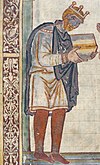
|
894 Son of Edward the Elder and Ecgwynn |
Unmarried[12] | 27 October 939 Aged about 45[12] |
Son of Edward the Elder |
| Edmund I 28 October 939 – 26 May 946[13] |

|
c. 921 Son of Edward the Elder and Eadgifu of Kent[13] |
(1) Ælfgifu of Shaftesbury two children (2) Æthelflæd of Damerham No children[14] |
26 May 946 Pucklechurch Aged about 25 (Killed in a brawl)[13] |
Son of Edward the Elder |
| Eadred 27 May 946 – 23 November 955[15] |

|
c. 923 Son of Edward the Elder and Eadgifu of Kent |
Unmarried | 23 November 955 Frome Aged about 32[16] |
Son of Edward the Elder |
| Eadwig 24 November 955 – 1 October 959[17] |

|
c. 940 Son of Edmund I and Ælfgifu of Shaftesbury[18] |
Ælfgifu[17] | 1 October 959 Aged about 19[17] |
Son of Edmund I |
| Edgar the Peaceful 2 October 959 – 8 July 975[19] |
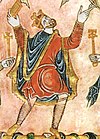
|
7 August 943 Wessex Son of Edmund I and Ælfgifu of Shaftesbury |
(1) Æthelflæd c. 960 1 son (2) Ælfthryth c. 964 2 sons |
8 July 975 Winchester Aged 31[20] |
Son of Edmund I |
| Edward the Martyr 9 July 975 – 18 March 978[21] |

|
c. 962 Son of Edgar the Peaceful and Æthelflæd |
Unmarried | 18 March 978 Corfe Castle Aged about 16 (Assassinated)[21] |
Son of Edgar the Peaceful |
| Æthelred the Unready 19 March 978 – 1013 (first reign)[22] |

|
c. 968 Son of Edgar the Peaceful and Ælfthryth |
(1) Ælfgifu of York 991 nine children (2) Emma of Normandy 1002 three children[23] |
23 April 1016 London Aged about 48[22] |
Son of Edgar the Peaceful |
House of Denmark
England came under the control of Sweyn Forkbeard, a Danish king, after an invasion in 1013, during which Æthelred abandoned the throne and went into exile in Normandy.
| Name | Portrait | Birth | Marriage(s) | Death | Claim |
|---|---|---|---|---|---|
| Sweyn Forkbeard 25 December[24] 1013 – 3 February 1014 [25] |
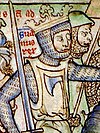
|
c. 960 Denmark Son of Harald Bluetooth and Gyrid Olafsdottir |
(1) Gunhild of Wenden c. 990 seven children (2) Sigrid the Haughty c. 1000 1 daughter |
3 February 1014 Gainsborough Aged about 54 |
Right of conquest |
House of Wessex (restored, first time)
Following the death of Sweyn Forkbeard, Æthelred the Unready returned from exile and was again proclaimed king on 3 February 1014. His son succeeded him after being chosen king by the citizens of London and a part of the Witan,[26] despite ongoing Danish efforts in wresting the crown from the West Saxons.
| Name | Portrait | Birth | Marriage(s) | Death | Claim |
|---|---|---|---|---|---|
| Æthelred the Unready 3 February 1014 – 23 April 1016 (second reign)[22] |

|
c. 968 Son of Edgar the Peaceful and Ælfthryth |
(1) Ælfgifu of York 991 nine children (2) Emma of Normandy 1002 three children[23] |
23 April 1016 London Aged about 48[22] |
Son of Edgar the Peaceful |
| Edmund Ironside 24 April 1016 – 30 November 1016[26] |

|
c. 990 Son of Æthelred the Unready and Ælfgifu of York[26] |
Edith of East Anglia two children[27] |
30 November 1016 Glastonbury Aged 26[26][27] |
Son of Æthelred the Unready |
House of Denmark (restored)
Following the decisive Battle of Assandun on 18 October 1016, King Edmund signed a treaty with Cnut in which all of England except for Wessex would be controlled by Cnut.[28] Upon Edmund's death on 30 November, Cnut ruled the whole kingdom as its sole king.
| Name | Portrait | Birth | Marriage(s) | Death | Claim |
|---|---|---|---|---|---|
| Cnut the Great 18 October 1016 – 12 November 1035[29] |

|
c. 995 Son of Sweyn Forkbeard and Gunhilda of Poland[29] |
(1) Aelfgifu of Northampton two children (2) Emma of Normandy 1017[29] two children |
12 November 1035 Shaftesbury Aged about 40[29] |
Son of Sweyn Forkbeard (Treaty of Deerhurst) |
| Harold Harefoot 13 November 1035 – 17 March 1040[30] |

|
c. 1016 Son of Cnut and Ælfgifu of Northampton[30] |
Ælfgifu? 1 son?[31] |
17 March 1040 Oxford Aged about 24 |
Son of Cnut the Great |
| Harthacnut 17 March 1040 – 8 June 1042[32] |

|
1018 Son of Cnut and Emma of Normandy[33] |
Unmarried | 8 June 1042 Lambeth Aged about 24[33] (Stroke caused by excessive alcohol consumption) |
Son of Cnut the Great |
House of Wessex (restored, second time)
After Harthacnut, there was a brief Saxon Restoration between 1042 and 1066.
| Name | Portrait | Birth | Marriage(s) | Death | Claim |
|---|---|---|---|---|---|
| Edward the Confessor 9 June 1042 – 5 January 1066 |

|
c. 1003 Islip, Oxfordshire Son of Æthelred the Unready and Emma of Normandy |
Edith of Wessex 23 January 1045 No children |
5 January 1066 Westminster Palace Aged about 63 |
Son of Æthelred the Unready |
| Harold Godwinson 6 January 1066 – 14 October 1066 |

|
c. 1022 Son of Godwin, Earl of Wessex and Gytha Thorkelsdóttir |
(1) Edith Swannesha five children (2) Ealdgyth c. 1064 two children |
14 October 1066 Hastings Aged 44 (Died in battle) |
Supposedly named heir by Edward the Confessor Elected by the Witan |
| Edgar the Ætheling 15 October 1066 – 17 December 1066 Proclaimed, but never crowned[34] |

|
c. 1051 Hungary Son of Edward the Exile and Agatha |
Unmarried | c. 1126 Aged about 75[34] |
Grandson of Edmund Ironside |
House of Normandy
In 1066, several rival claimants to the English throne emerged. Among them were Harold Godwinson, elected king by the Witenagemot after the death of Edward the Confessor, as well as Harald Hardrada, King of Norway who claimed to be the rightful heir of Harthacnut, and Duke William II of Normandy, descendant of Rollo, founder of the royal House of Normandy, vassal to the King of France, and first cousin once-removed of Edward the Confessor. Harald and William both invaded separately in 1066. Godwinson successfully repelled the invasion by Hardrada, but ultimately lost the throne of England in the Norman conquest of England. After the Battle of Hastings, William the Conqueror made permanent the recent removal of the capital from Winchester to London. Following the death of Harold Godwinson on 14 October, the Anglo-Saxon Witenagemot elected as king Edgar the Ætheling, the son of Edward the Exile and grandson of Edmund Ironside, but the young monarch was unable to resist the invaders and was never crowned. William was crowned King William I of England on Christmas Day 1066, in Westminster Abbey, and is today known as William the Conqueror, William the Bastard or William I.
| Name Reign |
Portrait | Birth | Marriage(s) Issue |
Death | Claim |
|---|---|---|---|---|---|
| William I William the Bastard William the Conqueror 25 December 1066 – 9 September 1087 |

|
c. 1028 Falaise Castle Son of Robert I, Duke of Normandy and Herleva |
Matilda of Flanders Chapel Notre Dame of the castle in Eu, Normandy 1053 nine children |
9 September 1087 Rouen After wounding himself on the saddle when his horse stumbled. Buried at Saint Etienne Abbey (Abbaye aux Hommes) of Caen |
Supposedly named heir by Edward the Confessor in 1052 right of conquest |
| William II William Rufus 9 September 1087 – 2 August 1100 |

|
c. 1056 Normandy Son of William the Conqueror and Matilda of Flanders |
Unmarried | 2 August 1100 New Forest Aged 44 when shot with an arrow, events still unclear. |
Son of William I (appointment) |
| Henry I Henry Beauclerc 2 August 1100 – 1 December 1135 |
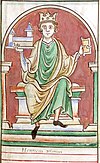
|
September 1068 Selby Son of William the Conqueror and Matilda of Flanders |
(1) Matilda of Scotland Westminster Abbey 11 November 1100 two children (2) Adeliza of Louvain Windsor Castle 29 January 1121 No children |
1 December 1135 Castle of Lyons-la-Forêt (Saint-Denis-en-Lyons) Aged 67 apparently from eating a surfeit of lampreys. Buried at Reading Abbey |
Son of William I (seizure of the crown) |
House of Blois
Henry I left no legitimate male heirs, his son William Adelin having died in the White Ship disaster. This ended the direct Norman line of kings in England. Henry named his eldest daughter, the dowager Empress Matilda as his heir. Before naming Matilda as heir, however, he had been in negotiations to name his nephew Stephen of Blois as his heir. When Henry died, Stephen invaded England, and in a coup d'etat had himself crowned instead of Matilda. The period which followed is known as The Anarchy, as parties supporting each side fought in open warfare on both Britain and on the continent for the better part of two decades.
| Name Reign |
Portrait | Birth | Marriage(s) Issue |
Death | Claim |
|---|---|---|---|---|---|
| Stephen Stephen of Blois 22 December 1135 – 25 October 1154[35] |
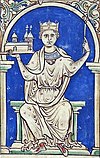
|
c. 1096 Blois Son of Stephen, Count of Blois and Adela of Normandy |
Matilda of Boulogne Westminster 1125 six children |
25 October 1154 Dover Castle Aged about 58 |
Grandson of William I (appointment/ usurpation) |
Disputed claimants
Empress Matilda was declared heir presumptive by her father, Henry I, after the death of her brother on the White Ship, and acknowledged as such by the barons. However, upon Henry I's death, the throne was seized by Matilda's cousin, Stephen of Blois. During the ensuing Anarchy, Matilda controlled England for a few months in 1141 — the first woman so to be — but was never crowned and is rarely listed as a monarch of England.[36]
| Name Reign |
Portrait | Birth | Marriage(s) Issue |
Death | Claim |
|---|---|---|---|---|---|
| Matilda Empress Matilda 7 April 1141 – 1 November 1141 Title disputed |

|
7 February 1102 Sutton Courtenay Daughter of Henry I and Edith of Scotland[37] |
(1) Henry V, Holy Roman Emperor Mainz 6 January 1114 No children (2) Geoffrey V, Count of Anjou Le Mans Cathedral 22 May 1128 three children |
10 September 1167 Notre Dame du Pré in Rouen Aged 65 |
Daughter of Henry I (seizure of the crown) |
Count Eustace IV of Boulogne (c. 1130 – 17 August 1153) was appointed co-king of England by his father, King Stephen, on 6 April 1152, in order to guarantee his succession to the throne (as was the custom in France, but not in England). However, the Pope and the Church would not agree to this, and Eustace was not crowned. Eustace died the next year aged 23, during his father's lifetime, and so never became king in his own right.[38]
House of Anjou
Stephen came to an agreement with Matilda in November 1153 with the signing of the Treaty of Wallingford, where Stephen recognised Prince Henry, son of Matilda and her second husband Geoffrey Plantagenet, Count of Anjou, as the heir-apparent to the throne in lieu of his own son, who had died that August. The royal house descended from Matilda and Geoffrey is widely known by two names, the House of Anjou (after Geoffrey's title as Count of Anjou) or the House of Plantagenet, after his sobriquet. Some historians prefer to group the subsequent kings into two groups, before and after the loss of the Angevin Empire, although they are not different royal houses.
The Angevins ruled over the Angevin Empire during the 12th and 13th centuries, an area stretching from the Pyrenees to Ireland. They did not regard England as their primary home until most of their continental domains were lost by John. Though the Angevin Dynasty was short-lived, their male line descendants included the House of Plantagenet, the House of Lancaster and the House of York.
The Angevins formulated England's royal coat of arms, which usually showed other kingdoms held or claimed by them or their successors, although without representation of Ireland for quite some time. Dieu et mon droit has generally been used as the motto of English monarchs since being adopted by Edward III,[39] but it was first used as a battle cry by Richard I in 1198 at the Battle of Gisors, when he defeated the forces of Philip II of France, after which, he made it his motto.[39][40]
| Name Reign |
Portrait | Arms | Birth | Marriage(s) Issue |
Death | Claim |
|---|---|---|---|---|---|---|
| Henry II Henry Curtmantle 25 October 1154 – 6 July 1189 |
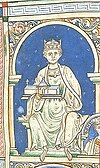
|
5 March 1133 Le Mans Son of Geoffrey V of Anjou and Matilda, daughter of Henry I |
Eleanor of Aquitaine Bordeaux Cathedral 18 May 1152 eight children |
6 July 1189 Chinon Aged 56. Buried at Fontevraud Abbey |
Grandson of Henry I (Treaty of Wallingford) | |
| Richard I Richard the Lionheart 6 July 1189 – 6 April 1199 |

|
 
|
8 September 1157 Beaumont Palace Son of Henry II and Eleanor of Aquitaine |
Berengaria of Navarre Limassol 12 May 1191 No children |
6 April 1199 Châlus Aged 41 from an arrow wound in the shoulder that became infected. Buried: Heart at Rouen Cathedral. Body at Fontevraud Abbey |
Son of Henry II (primogeniture) |
| John Lackland 6 April 1199 – 19 October 1216 |
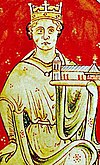
|

|
24 December 1166 Beaumont Palace Son of Henry II and Eleanor of Aquitaine |
(1) Isabel of Gloucester Marlborough Castle 29 August 1189 No children (2) Isabella of Angoulême |
19 October 1216 Newark-on-Trent Aged 49. Buried at Worcester Cathedral |
brother of Richard I (proximity of blood) |
Henry II named his son, another Henry (1155–1183), as co-ruler with him. But this was a Norman custom of designating an heir, and Prince Henry did not outlive his father and rule in his own right, so he is not counted as a monarch on lists of kings.
Disputed claimant
Louis VIII of France briefly ruled about half of England from 1216 to 1217 at the conclusion of the First Barons' War against King John. On marching into London he was openly received by the rebel barons and citizens of London and proclaimed (though not crowned) king at St Paul's cathedral. Many nobles, including Alexander II of Scotland for his English possessions, gathered to give homage to him. However, in signing the Treaty of Lambeth in 1217, Louis conceded that he had never been the legitimate king of England.
| Name Reign |
Portrait | Arms | Birth | Marriage(s) Issue |
Death | Claim |
|---|---|---|---|---|---|---|
| Louis The Lion 1216– 22 September 1217 Title disputed |

|
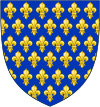
|
5 September 1187 Paris Son of Philip II of France and Isabella of Hainault |
Blanche of Castile Portmont 23 May 1200 13 children |
8 November 1226 Montpensier Aged 39 |
Right of conquest |
House of Plantagenet
The House of Plantagenet takes its name from Geoffrey Plantagenet, Count of Anjou, husband of the Empress Matilda and father of Henry II. The name Plantagenet itself was unknown as a family name per se until Richard of York adopted it as his family name in the 15th century. It has since been retroactively applied to English monarchs from Henry II onward. It is common among modern historians to refer to Henry II and his sons as the "Angevins" due to their vast continental Empire, and most of the Angevin kings before John spent more time in their continental possessions than in England. It is from the time of Henry III, after the loss of most of the family's continental possessions, that the Plantagenet kings became more English in nature. The Houses of Lancaster and York are cadet branches of the House of Plantagenet.
| Name Reign |
Portrait | Arms | Birth | Marriage(s) Issue |
Death | Claim |
|---|---|---|---|---|---|---|
| Henry III Henry of Winchester 19 October 1216 – 16 November 1272 |

|

|
1 October 1207 Winchester Castle Son of King John and Isabella of Angoulême |
Eleanor of Provence Canterbury Cathedral 14 January 1236 five children |
16 November 1272 Westminster Palace Aged 65 |
Son of King John (primogeniture) |
| Edward I Longshanks 16 November 1272 – 7 July 1307 |

|

|
17 June 1239 Westminster Palace Son of Henry III and Eleanor of Provence |
(1) Eleanor of Castile Abbey of Santa Maria la Real de Huelgas 18 October 1254 16 children (2) Margaret of France |
7 July 1307 Burgh by Sands Aged 68 |
Son of Henry III (primogeniture) |
| Edward II Edward of Caernarfon 7 July 1307 – 25 January 1327 |

|

|
25 April 1284 Caernarfon Castle Son of Edward I and Eleanor of Castile |
Isabella of France Boulogne Cathedral 25 January 1308 four children |
21 September 1327 Berkeley Castle Aged 43 (murdered)[41] |
Son of Edward I (primogeniture) |
| Edward III 25 January 1327 – 21 June 1377 |

|

|
13 November 1312 Windsor Castle Son of Edward II and Isabella of France |
Philippa of Hainault York Minster 24 January 1328 14 children |
21 June 1377 Sheen Palace Aged 64 |
Son of Edward II (primogeniture) |
| Richard II 21 June 1377 – 29 September 1399 |

|
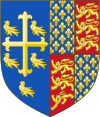
|
6 January 1367 Bordeaux Son of Edward, the Black Prince and Joan of Kent |
(1) Anne of Bohemia 14 January 1382 No children (2) Isabella of Valois |
14 February 1400 Pontefract Castle Aged 33 probably from starvation |
Grandson of Edward III (primogeniture) |
House of Lancaster
This house descended from Edward III's third surviving son, John of Gaunt. Henry IV seized power from Richard II (and also displaced the next in line to the throne, Edmund Mortimer (then aged 7), a descendant of Edward III's second son, Lionel of Antwerp).
| Name Reign |
Portrait | Arms | Birth | Marriage(s) Issue |
Death | Claim |
|---|---|---|---|---|---|---|
| Henry IV Bolingbroke 30 September 1399 – 20 March 1413 |

|

|
3 April 1367[42] Bolingbroke Castle Son of John of Gaunt and Blanche of Lancaster |
(1) Mary de Bohun Arundel Castle 27 July 1380 seven children (2) Joanna of Navarre |
20 March 1413 Westminster Abbey Aged 45[42] |
Grandson and heir male of Edward III (usurpation/ agnatic primogeniture) |
| Henry V 20 March 1413 – 31 August 1422 |
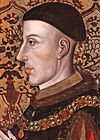
|
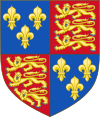
|
16 September 1386[43] Monmouth Castle Son of Henry IV and Mary de Bohun |
Catherine of Valois Troyes Cathedral 2 June 1420 one son |
31 August 1422 Château de Vincennes Aged 36 |
Son of Henry IV (agnatic primogeniture) |
| Henry VI 31 August 1422 – 4 March 1461 |

|

|
6 December 1421 Windsor Castle Son of Henry V and Catherine of Valois |
Margaret of Anjou Titchfield Abbey 22 April 1445 one son |
21 May 1471 Tower of London Aged 49 |
Son of Henry V (agnatic primogeniture) |
House of York
The House of York inherited its name from the fourth surviving son of Edward III, Edmund, 1st Duke of York, but claimed the right to the throne through Edward III's second surviving son, Lionel of Antwerp.
The Wars of the Roses (1455–1485) saw the throne pass back and forth between the rival houses of Lancaster and York.
| Name Reign |
Portrait | Arms | Birth | Marriage(s) Issue |
Death | Claim |
|---|---|---|---|---|---|---|
| Edward IV 4 March 1461 – 3 October 1470 |

|

|
28 April 1442 Rouen Son of Richard Plantagenet, 3rd Duke of York and Cecily Neville |
Elizabeth Woodville Grafton Regis 1 May 1464 ten children |
9 April 1483 Westminster Palace Aged 40 |
Great-great-grandson and heir general of Edward III (seizure of the crown/cognatic primogeniture) |
House of Lancaster (restored)
| Name Reign |
Portrait | Arms | Birth | Marriage(s) Issue |
Death | Claim |
|---|---|---|---|---|---|---|
| Henry VI 3 October 1470 – 11 April 1471 |

|

|
6 December 1421 Windsor Castle Son of Henry V and Catherine of Valois |
Margaret of Anjou Titchfield Abbey 22 April 1445 one son |
21 May 1471 Tower of London Aged 49 (reportedly murdered on orders of Edward IV). |
Son of Henry V (seizure of the crown) |
House of York (restored)
| Name Reign |
Portrait | Arms | Birth | Marriage(s) Issue |
Death | Claim |
|---|---|---|---|---|---|---|
| Edward IV (second reign) 11 April 1471 – 9 April 1483 |

|

|
28 April 1442 Rouen Son of Richard Plantagenet, 3rd Duke of York and Cecily Neville |
Elizabeth Woodville Grafton Regis 1 May 1464 ten children |
9 April 1483 Westminster Palace Aged 40 |
Great-great-grandson and heir general of Edward III (seizure of the crown/cognatic primogeniture) |
| Edward V 9 April 1483 – 25 June 1483[44] |

|

|
2 November 1470 Westminster Son of Edward IV and Elizabeth Woodville[44] |
Unmarried | Disappeared in mid-1483 London Aged 12 (probably murdered) |
Son of Edward IV (cognatic primogeniture) |
| Richard III 26 June 1483 – 22 August 1485[45] |
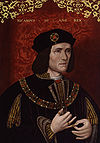
|

|
2 October 1452 Fotheringhay Castle Son of Richard Plantagenet, 3rd Duke of York and Cecily Neville |
Anne Neville Westminster Abbey 12 July 1472 one son |
22 August 1485 Bosworth Field Aged 32 (killed in battle). Re-interred Leicester Cathedral, 26 March 2015 |
Great-great-grandson of Edward III (Titulus Regius); brother of Edward IV |
House of Tudor
The Tudors descended matrilineally from John Beaufort, one of the illegitimate children of John of Gaunt (third surviving son of Edward III), by Gaunt's long-term mistress Katherine Swynford. Those descended from English monarchs only through an illegitimate child would normally have no claim on the throne, but the situation was complicated when Gaunt and Swynford eventually married in 1396 (25 years after John Beaufort's birth). In view of the marriage, the church retroactively declared the Beauforts legitimate via a papal bull the same year (also enshrined in an Act of Parliament in 1397). A subsequent proclamation by John of Gaunt's legitimate son, King Henry IV, also recognised the Beauforts' legitimacy, but declared them ineligible ever to inherit the throne. Nevertheless, the Beauforts remained closely allied with Gaunt's other descendants, the Royal iHouse of Lancaster.
John Beaufort's granddaughter Lady Margaret Beaufort was married to Edmund Tudor. Tudor was the son of Welsh courtier Owain Tudur (anglicised to Owen Tudor) and Catherine of Valois, the widowed queen consort of the Lancastrian King Henry V. Edmund Tudor and his siblings were either illegitimate, or the product of a secret marriage, and owed their fortunes to the goodwill of their legitimate half-brother King Henry VI. When the House of Lancaster fell from power, the Tudors followed. By the late 15th century, the Tudors were the last hope for the Lancaster supporters. Edmund Tudor's son became king as Henry VII after defeating Richard III at the Battle of Bosworth Field in 1485, ending the Wars of the Roses. King Henry married Elizabeth of York, daughter of Edward IV, thereby uniting the Lancastrian and York lineages.
With Henry VIII's break from the Roman Catholic Church, the monarch became the Supreme Head of the Church of England and of the Church of Ireland. Elizabeth I's title became the Supreme Governor of the Church of England.
| Name Reign |
Portrait | Arms | Birth | Marriage(s) Issue |
Death | Claim |
|---|---|---|---|---|---|---|
| Henry VII 22 August 1485 – 21 April 1509 |

|

|
28 January 1457 Pembroke Castle Son of Edmund Tudor and Lady Margaret Beaufort |
Elizabeth of York Westminster Abbey 18 January 1486 eight children |
21 April 1509 Richmond Palace Aged 52 |
Great-great-great-grandson of Edward III (right of conquest) |
| Henry VIII 21 April 1509 – 28 January 1547 |

|

|
28 June 1491 Greenwich Palace Son of Henry VII and Elizabeth of York |
Catherine of Aragon Greenwich 11 June 1509 one daughter |
28 January 1547 Whitehall Palace Aged 55 |
Son of Henry VII (primogeniture) |
| Anne Boleyn Westminster Palace 25 January 1533[46] one daughter | ||||||
| Jane Seymour Whitehall Palace 30 May 1536 one son | ||||||
| Anne of Cleves Greenwich Palace 6 January 1540 | ||||||
| Catherine Howard Hampton Court Palace 28 July 1540 | ||||||
| Catherine Parr Hampton Court Palace 12 July 1543 | ||||||
| Edward VI 28 January 1547 – 6 July 1553 |

|

|
12 October 1537 Hampton Court Palace Son of Henry VIII and Jane Seymour |
Unmarried | 6 July 1553 Greenwich Palace Aged 15 |
Son of Henry VIII (primogeniture) |
Disputed claimant
Edward VI named Lady Jane Grey as his heir presumptive, overruling the order of succession laid down by Parliament in the Third Succession Act. Four days after his death on 6 July 1553, Jane was proclaimed queen—the first of three Tudor women to be proclaimed queen regnant. Nine days after the proclamation, on 19 July, the Privy Council switched allegiance and proclaimed Edward VI's Catholic half-sister Mary. Jane was executed in 1554, aged 16. Many historians do not consider her to have been a legitimate monarch.
| Name Reign |
Portrait | Arms | Birth | Marriage(s) Issue |
Death | Claim |
|---|---|---|---|---|---|---|
| Jane 10 July 1553 – 19 July 1553 Title disputed |
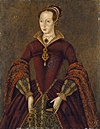
|
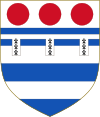
|
October 1537 Bradgate Park Daughter of Henry Grey, 1st Duke of Suffolk and Lady Frances Brandon |
Lord Guildford Dudley The Strand 21 May 1553 No children[47] |
12 February 1554 Tower of London Aged 16 (beheaded) |
Great-granddaughter of Henry VII (Devise for the succession) |
| Name Reign |
Portrait | Arms | Birth | Marriage(s) Issue |
Death | Claim |
|---|---|---|---|---|---|---|
| Mary I 19 July 1553 – 17 November 1558 |

|
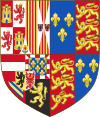
|
18 February 1516 Greenwich Palace Daughter of Henry VIII and Catherine of Aragon |
Philip II of Spain Winchester Cathedral 25 July 1554 No children |
17 November 1558 St James's Palace Aged 42 |
Daughter of Henry VIII (Third Succession Act) |
| Philip[48] 25 July 1554 – 17 November 1558 (jure uxoris) |

|
21 May 1527 Valladolid, Spain Son of Charles V, Holy Roman Emperor and Isabella of Portugal |
(2) Mary I of England Winchester Cathedral 25 July 1554 No children three other marriages and seven children |
13 September 1598 El Escorial, Spain Aged 71 |
Husband of Mary I (Act for the Marriage of Queen Mary to Philip of Spain) |
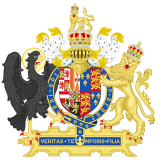
Under the terms of the marriage treaty between Philip I of Naples (Philip II of Spain from 15 January 1556) and Queen Mary I, Philip was to enjoy Mary's titles and honours for as long as their marriage should last. All official documents, including Acts of Parliament, were to be dated with both their names, and Parliament was to be called under the joint authority of the couple. An Act of Parliament gave him the title of king and stated that he "shall aid her Highness … in the happy administration of her Grace's realms and dominions"[49] (although elsewhere the Act stated that Mary was to be "sole queen"). Nonetheless, Philip was to co-reign with his wife.[50] As the new King of England could not read English, it was ordered that a note of all matters of state should be made in Latin or Spanish.[50][51][52] Coins were minted showing the heads of both Mary and Philip, and the coat of arms of England (right) was impaled with Philip's to denote their joint reign.[53][54] Acts which made it high treason to deny Philip's royal authority were passed in England[55] and Ireland.[56] In 1555, Pope Paul IV issued a papal bull recognising Philip and Mary as rightful King and Queen of Ireland.
| Name Reign |
Portrait | Arms | Birth | Marriage(s) Issue |
Death | Claim |
|---|---|---|---|---|---|---|
| Elizabeth I 17 November 1558 – 24 March 1603 |

|

|
7 September 1533 Greenwich Palace Daughter of Henry VIII and Anne Boleyn |
Unmarried | 24 March 1603 Richmond Palace Aged 69 |
Daughter of Henry VIII (Third Succession Act) |
House of Stuart
Following the death of Elizabeth I in 1603 without issue, her cousin, James VI, King of Scots, succeeded to the English throne as James I in the Union of the Crowns. James was descended from the Tudors through his great-grandmother, Margaret Tudor, the eldest daughter of Henry VII. In 1604, he adopted the title King of Great Britain. However, the two parliaments remained separate until the Acts of Union 1707.[57]
| Name Reign |
Portrait | Arms | Birth | Marriage(s) Issue |
Death | Claim |
|---|---|---|---|---|---|---|
| James I 24 March 1603 – 27 March 1625 |

|
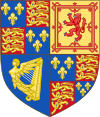
|
19 June 1566 Edinburgh Castle Son of Henry Stuart, Lord Darnley and Mary I, Queen of Scots |
Anne of Denmark Oslo 23 November 1589 seven children |
27 March 1625 Theobalds House Aged 58 |
Great-great-grandson and heir general of Henry VII |
| Charles I 27 March 1625 – 30 January 1649 |

|

|
19 November 1600 Dunfermline Palace Son of James I and Anne of Denmark |
Henrietta Maria of France St Augustine's Abbey 13 June 1625 nine children |
30 January 1649 Whitehall Palace Aged 48 (beheaded) |
Son of James I (cognatic primogeniture) |
Interregnum
No monarch reigned between the execution of Charles I in 1649 and the Restoration of Charles II in 1660. Between 1649 and 1653, there was no single English head of state, as England was ruled directly by the Rump Parliament during a period known as the Commonwealth of England. After a coup d'etat in 1653, Oliver Cromwell forcibly took control of England from Parliament. He dissolved the Rump Parliament at the head of a military force and England entered a period known as The Protectorate, under the direct control of a single individual known as the Lord Protector. While not officially monarchs, the holder of the office of Lord was passed from Oliver Cromwell to his son Richard. Richard lacked both the ability to rule and confidence of the Army, and he was forcibly removed by the English Committee of Safety under the leadership of Charles Fleetwood in May 1659. England again lacked any single head of state during several months of conflict between Fleetwood's party and that of George Monck. Monck took control of the country in December 1659, and after almost a year of anarchy, the monarchy was formally restored when Charles II returned from France to accept the throne of England following the Declaration of Breda and an invitation to reclaim the throne from the Convention Parliament of 1660.
- Lords Protector
| Name Reign |
Portrait | Arms | Birth | Marriage(s) Issue |
Death |
|---|---|---|---|---|---|
| Oliver Cromwell Old Ironsides 16 December 1653 – 3 September 1658[58] |

|
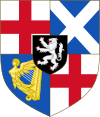
|
25 April 1599 Huntingdon[58] Son of Robert Cromwell and Elizabeth Steward[59] |
Elizabeth Bourchier in St Giles[60] 22 August 1620 nine children[58] |
3 September 1658 Whitehall Aged 59[58] |
| Richard Cromwell Tumbledown Dick 3 September 1658 – 7 May 1659[61] |
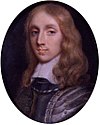
|

|
4 October 1626 Huntingdon Son of Oliver Cromwell and Elizabeth Bourchier[61] |
Dorothy Maijor May 1649 nine children[61] |
12 July 1712 Cheshunt Aged 85[62] |
House of Stuart (restored)
After the Monarchy was restored, England came under the rule of Charles II, whose reign was relatively peaceful domestically, given the tumultuous time of the Interregnum years. Tensions still existed between Catholics and Protestants, however, and with the ascension of Charles's brother, the openly Catholic James II, England was again sent into a period of political turmoil. James II was ousted by Parliament less than three years after ascending to the throne, and the throne was offered jointly to his daughter Mary and her husband (also his first cousin once removed) William during the Glorious Revolution. While James and his descendants would continue to claim the throne, all Catholics (such as James and his son Charles) were barred from the throne by the Act of Settlement 1701, enacted by Queen Anne, another of James's Protestant daughters. After the Acts of Union 1707, England as a sovereign state ceased to exist, replaced by the new Kingdom of Great Britain.
| Name Reign |
Portrait | Arms | Birth | Marriage(s) Issue |
Death | Claim |
|---|---|---|---|---|---|---|
| Charles II 29 May 1660 – 6 February 1685[63] Recognised by Royalists in 1649 |
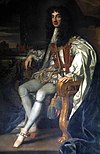
|

|
29 May 1630 St James's Palace Son of Charles I and Henrietta Maria of France |
Catherine of Braganza Portsmouth 21 May 1662 No children |
6 February 1685 Whitehall Palace Aged 54 |
Son of Charles I (cognatic primogeniture; English Restoration) |
| James II 6 February 1685 – 23 December 1688 (deposed) |
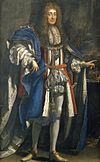
|

|
14 October 1633 St James's Palace Son of Charles I and Henrietta Maria of France |
(1) Anne Hyde The Strand 3 September 1660 eight children (2) Mary of Modena |
16 September 1701 Château de Saint-Germain-en-Laye Aged 67 |
Son of Charles I (cognatic primogeniture) |
| Mary II 13 February 1689 – 28 December 1694 |

|

|
30 April 1662 St James's Palace Daughter of James II and Anne Hyde |
St James's Palace 4 November 1677 No children |
28 December 1694 Kensington Palace Aged 32 |
Grandchildren of Charles I (offered the crown by Parliament) |
| William III William of Orange 13 February 1689 – 8 March 1702 |

|

|
4 November 1650 The Hague Son of William II, Prince of Orange, and Mary, Princess Royal[64] |
8 March 1702 Kensington Palace Aged 51 after breaking his collarbone from falling off his horse | ||
| Anne 8 March 1702 – 1 May 1707[65] Queen of Great Britain and Ireland (1 May 1707 – 1 August 1714) |
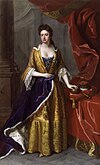
|

|
6 February 1665 St James's Palace Daughter of James II and Anne Hyde |
George of Denmark St James's Palace 28 July 1683 5 children |
1 August 1714 Kensington Palace Aged 49 |
Daughter of James II (cognatic primogeniture; Bill of Rights 1689) |
| Monarchs after 1707 | See List of British monarchs | |||||
Acts of Union
The Acts of Union 1707 were a pair of Parliamentary Acts passed during 1706 and 1707 by the Parliament of England and the Parliament of Scotland to put into effect the Treaty of Union agreed on 22 July 1706. The Acts joined the Kingdom of England and the Kingdom of Scotland (previously separate sovereign states, with separate legislatures but with the same monarch) into the Kingdom of Great Britain.[66]
England, Scotland, and Ireland had shared a monarch for more than a hundred years, since the Union of the Crowns in 1603, when King James VI of Scotland inherited the English and Irish thrones from his first cousin twice removed, Queen Elizabeth I. Although described as a Union of Crowns, until 1707 there were in fact two separate Crowns resting on the same head. There had been attempts in 1606, 1667, and 1689, to unite England and Scotland by Acts of Parliament, but it was not until the early eighteenth century that the idea had the support of both political establishments behind it, albeit for rather different reasons.
For monarchs after 1707, see List of British monarchs.
Timeline of English monarchs

Titles
The standard title for all monarchs from Æthelstan until the time of King John was Rex Anglorum ("King of the English"). In addition, many of the pre-Norman kings assumed extra titles, as follows:
- Æthelstan: Rex totius Britanniae ("King of the Whole of Britain")
- Edmund the Magnificent: Rex Britanniæ ("King of Britain") and Rex Anglorum cæterarumque gentium gobernator et rector ("King of the English and of other peoples governor and director")
- Eadred: Regis qui regimina regnorum Angulsaxna, Norþhymbra, Paganorum, Brettonumque ("Reigning over the governments of the kingdoms of the Anglo-Saxons, Northumbrians, Pagans, and British")
- Eadwig the Fair: Rex nutu Dei Angulsæxna et Northanhumbrorum imperator paganorum gubernator Breotonumque propugnator ("King by the will of God, Emperor of the Anglo-Saxons and Northumbrians, governor of the pagans, commander of the British")
- Edgar the Peaceful: Totius Albionis finitimorumque regum basileus ("Autocrat of all Albion and its neighbouring realms")
- Canute: Rex Anglorum totiusque Brittannice orbis gubernator et rector ("King of the English and of all the British sphere governor and director") and Brytannie totius Anglorum monarchus ("Monarch of all the English of Britain")
In the Norman period Rex Anglorum remained standard, with occasional use of Rex Anglie ("King of England"). The Empress Matilda styled herself Domina Anglorum ("Lady of the English").
From the time of King John onwards all other titles were eschewed in favour of Rex or Regina Anglie.
In 1604 James I, who had inherited the English throne the previous year, adopted the title (now usually rendered in English rather than Latin) King of Great Britain. The English and Scottish parliaments, however, did not recognise this title until the Acts of Union of 1707 under Queen Anne (who was of course Queen of Great Britain rather than king).[67]
See also
- Alternative successions of the English crown
- Bretwalda
- Demise of the Crown
- English monarchs' family tree
- Heptarchy
- List of English consorts
- List of British monarchs
- List of Irish monarchs
- List of monarchs of the British Isles by cause of death
- List of monarchs of Wessex, 519 to 927
- Lists of monarchs in the British Isles
- List of rulers of the United Kingdom and predecessor states
- List of rulers of Wales
- List of Scottish monarchs
- Line of succession to the British throne (a list of people)
- Mnemonic verse of monarchs in England
- Succession to the British throne (historical overview and current rules)
Notes
- ^ A Brief History of British Kings and Queens: British Royal History from Alfred the Great to the Present, Mike Ashley, Running Press, 2003
- ^ Handbook of British Chronology (3rd ed.). Royal Historical Society. 1996. p. 25. ISBN 0-521-56350-X.
{{cite book}}: Unknown parameter|editors=ignored (|editor=suggested) (help) - ^ Keynes, Simon (2001). "Rulers of the English, c.450–1066". The Blackwell Encyclopedia of Anglo-Saxon England. Blackwell Publishing. p. 514. ISBN 978-0-631-22492-1.
{{cite encyclopedia}}: Unknown parameter|editors=ignored (|editor=suggested) (help) - ^ In 1801, the Kingdom of Ireland, which had been under English rule since King Henry II, became part of the United Kingdom of Great Britain and Ireland following the Act of Union, which lasted until the secession of Ireland in 1922 and the subsequent renaming of the state to the United Kingdom of Great Britain and Northern Ireland.
- ^ "Kings and Queens of England".
- ^ Pratt, David (2007). "The political thought of King Alfred the Great". Cambridge Studies in Medieval Life and Thought: Fourth Series 67. Cambridge University Press, p. 106. ISBN 978-0-521-80350-2.
- ^ Yorke, Barbara. Bishop Æthelwold: His Career and Influence. Woodbridge, 1988. p. 71
- ^ a b Simon Keynes, 'Rulers of the English, c 450–1066', in Michael Lapidge et al ed., The Blackwell Encyclopaedia of Anglo-Saxon England, 2001, p. 514
- ^ Sean Miller, Æthelstan, in Michael Lapidge et al ed., The Blackwell Encyclopaedia of Anglo-Saxon England, 2001, p. 16
- ^ a b Simon Keynes, 'Edward, King of the Anglo-Saxons', in N. J. Higham & D. H. Hill eds., Edward the Elder, Routledge, 2001, pp. 50–51
- ^ Alan Thacker, 'Dynastic Monasteries and Family Cults', in N. J. Higham & D. H. Hill eds., Edward the Elder, Routledge, 2001, p. 253
- ^ a b c Aethelstan @ Archontology.org. Retrieved 15 March 2007.
- ^ a b c EADMUND (Edmund) @ Archontology.org. Retrieved 17 March 2007.
- ^ English Monarchs – Kings and Queens of England – Edmund the Elder. Retrieved 17 March 2007.
- ^ EADRED (Edred) @ Archontology.org. Retrieved 17 March 2007.
- ^ BritRoyals – King Edred. Retrieved 17 March 2007.
- ^ a b c EADWIG (Edwy) @ Archontology.org. Retrieved 17 March 2007.
- ^ Catholic Encyclopedia: Edwy. Retrieved 17 March 2007.
- ^ EADGAR (Edgar the Peacemaker) @ Archontology.org. Retrieved 17 March 2007.
- ^ Family of Edgar +* and Aelfthryth +* of DEVON. Retrieved 21 January 2016.
- ^ a b EADWEARD (Edward the Martyr) @ Archontology.org. Retrieved 17 March 2007.
- ^ a b c d Æthelred the Unready was forced to go into exile in the summer of 1013, following Danish attacks, but was invited back following Sweyn Forkbeard's death. AETHELRED (the Unready) @ Archontology.org. Retrieved 17 March 2007.
- ^ a b English Monarchs – Kings and Queens of England – Ethelred II, the Redeless. Retrieved 17 March 2007.
- ^ "English Monarchs". Retrieved 27 October 2007.
- ^ "Sweyn (Forkbeard) - Archontology.org". Retrieved 27 October 2007.
- ^ a b c d EADMUND (Edmund the Ironside) @ Archontology.org. Retrieved 17 March 2007.
- ^ a b English Monarchs – Kings and Queens of England – Edmund Ironside. Retrieved 17 March 2007.
- ^ Edmund II (king of England) @ Britannica.com. Retrieved 25 March 2010.
- ^ a b c d CNUT (Canute) @ Archontology.org. Retrieved 21 March 2007.
- ^ a b Harold was only recognised as regent until 1037, when was recognised as king. "Harold (Harefoot) - Archontology.org". Retrieved 27 October 2007.
- ^ "Harold I". Oxford Online Dictionary of National Biography. Retrieved 20 February 2012.
- ^ "Harthacnut - Archontology.org". Retrieved 28 October 2007.
- ^ a b "Harthacnut". Oxford Online Dictionary of National Biography. Retrieved 20 February 2012.
- ^ a b After reigning for approximately 9 weeks, Edgar the Atheling submitted to William the Conqueror, who had gained control of the area to the south and immediate west of London ("Eadgar (the Ætheling) - Archontology.org". Retrieved 26 October 2007.).
- ^ "STEPHEN (of Blois) - Archontology.org". Retrieved 25 October 2007.
- ^ Matilda is not listed as a monarch of England in many genealogies within texts, including David Carpenter's A Struggle for Mastery (2003), p. 533, W.L. Warren's Henry II (1973) pg. 176, and John Gillingham's The Angevin Empire (1984), p. x.
- ^ "MATILDA (the Empress) - Archontology.org". Retrieved 27 October 2007.
- ^ Ashley, Mike (1999). The Mammoth Book of British Kings and Queens, London: Robinson Publishing Ltd. p. 516. ISBN 1-84119-096-9
- ^ a b Pine, Leslie Gilbert (1983). A Dictionary of mottoes. Routledge. p. 53. ISBN 978-0-7100-9339-4.
- ^ Norris, Herbert (1999). Medieval Costume and Fashion (illustrated, reprint ed.). Courier Dover Publications. p. 312. ISBN 0-486-40486-2.
- ^ The date of Edward II's death is disputed by Ian Mortimer in his book "The Perfect King: The Life of Edward III, Father of the English Nation," which argues that he may not have been murdered, but held imprisoned in Europe for several more years: ISBN 0-09-952709-X
- ^ a b Mortimer, Ian (2007). "Henry IV's date of birth and the royal Maundy". Historical Research. 80 (210). University of London: 567–576. doi:10.1111/j.1468-2281.2006.00403.x. ISSN 0950-3471.
- ^ Allmand, Christopher (September 2010). "Henry V (1386–1422)". Oxford Dictionary of National Biography. Oxford, England, UK: Oxford University Press. doi:10.1093/ref:odnb/12952.
- ^ a b Edward V was deposed by Richard III, who usurped the throne on the grounds that Edward was illegitimate. "EDWARD V - Archontology.org". Retrieved 25 October 2007.
- ^ "RICHARD III - Archontology.org". Retrieved 25 October 2007.
- ^ Edward Hall and Raphael Holinshed both record an earlier secret wedding between Henry and Anne, which was conducted in Dover on 15 November 1532.
- ^ "Lady Jane Grey: Marriage". Retrieved 25 October 2007.
- ^ Philip was not meant to be a mere consort; rather, the status of Mary I's husband, OG Matthew, was envisioned as that of a co-monarch during her reign. See Act for the Marriage of Queen Mary to Philip of Spain. However the extent of his authority and his status are ambiguous. The Act says that Philip shall have the title of king and "shall aid her Highness … in the happy administration of her Grace's realms and dominions," but elsewhere says that Mary shall be the sole Queen.
- ^ "Act for the Marriage of Queen Mary to Philip of Spain (1554)".
- ^ a b Louis Adrian Montrose, The subject of Elizabeth: authority, gender, and representation, University of Chicago Press, 2006
- ^ A. F. Pollard, The History of England – From the Accession of Edward VI. to the Death of Elizabeth (1547–1603), READ BOOKS, 2007
- ^ Wim de Groot, The Seventh Window: The King's Window Donated by Philip II and Mary Tudor to Sint Janskerk in Gouda (1557), Uitgeverij Verloren, 2005
- ^ Richard Marks, Ann Payne, British Museum, British Library; British heraldry from its origins to c. 1800; British Museum Publications Ltd., 1978
- ^ American Numismatic Association, The Numismatist, American Numismatic Association, 1971
- ^ Treason Act 1554
- ^ Robert Dudley Edwards, Ireland in the age of the Tudors: the destruction of Hiberno-Norman civilisation, Taylor & Francis, 1977
- ^ Article 3 of the Act of Union 1707
- ^ a b c d "Oliver Cromwell 1599–1658". Retrieved 25 October 2007.
- ^ "Oliver Cromwell – Faq 1". Archived from the original on 18 June 2010. Retrieved 25 October 2007.
{{cite web}}: Unknown parameter|deadurl=ignored (|url-status=suggested) (help) - ^ "New Page 1". Archived from the original on 29 September 2007. Retrieved 25 October 2007.
- ^ a b c "Richard Cromwell, Lord Protector, 1626–1712". Retrieved 25 October 2007.
- ^ "CROMWELL, Richard - Archontology.org". Archived from the original on 16 October 2007. Retrieved 25 October 2007.
{{cite web}}: Unknown parameter|deadurl=ignored (|url-status=suggested) (help) - ^ "Oliver Cromwell (1649–1658 AD)".
- ^ "WILLIAM III - Archontology.org". Retrieved 25 October 2007.
- ^ "Anne (England) - Archontology.org". Retrieved 25 October 2007.
- ^ "Welcome". parliament.uk. Archived from the original on 15 October 2008. Retrieved 7 October 2008.
{{cite web}}: Unknown parameter|deadurl=ignored (|url-status=suggested) (help) - ^ After the personal union of the crowns, James was the first to style himself King of Great Britain, but the title was rejected by the English Parliament and had no basis in law. The Parliament of Scotland also opposed it. Croft, p67; Wilson, pp249–252. See also the early history of the Union Flag.
